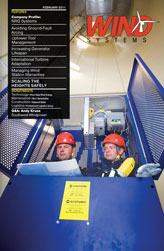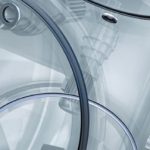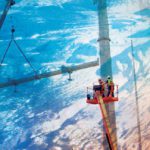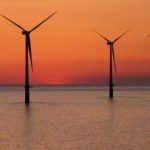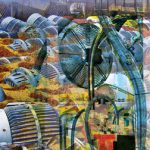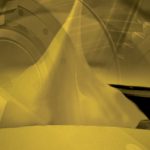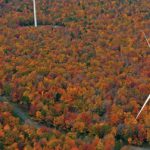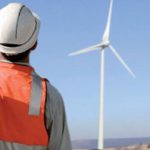Wind turbine generator OEMs, as well as suppliers of other plant equipment, generally offer a warranty for their products. In the wind industry it has become common to offer a warranty of one to two years after installation. Owners need to address how to manage those warranties, both for the wind turbine generators as well as for Balance of Plant (BOP) equipment. The reason why may be obvious regarding a wind turbine generator that has an installed cost of several million dollars, but BOP equipment is also warranted by its manufacturer. Because wind stations contain multiple repetitions of the same equipment, any single failure may be the precursor to many others.
During the warranty period repairs are usually performed by the OEM or a competent service provider, and almost always performed at zero cost to the owner. For example, output breakers, wind turbine generator pad-mounted transformers, and energy collection cables can all be visually inspected, and tower foundations can be inspected using an optical transit to detect settling, especially in regions with non-homogeneous geological strata.
Before the expiration of the wind turbine generator warranty period, owners need to prepare for accepting the OEM-supplied equipment. Ideally the equipment is turned over in the best condition possible. The owner needs to consider which of the following approaches best suits their needs.
First, the owner can simply accept the OEM report of the current wind turbine generator status, and receive the equipment “as is” at the end of the warranty period. This option is generally inadvisable, for a number of obvious reasons. Second, the owner can conduct an end-of-warranty (EoW) inspection just prior to the expiration of the warranty. This will establish the “as is” condition of the OEM-supplied equipment before the OEM leaves the site. For a fairly small investment of $3,000-$5,000 per wind turbine generator the status of each wind turbine generator is established by conducting a full inspection, an NDE (nondestructive evaluation), an NDT (nondestructive testing), or all three.
Third, in addition to the EoW inspection the owner can conduct periodic “benchmark” inspections, or spot checks, on select turbines throughout the warranty period to establish wind turbine generator and component status independently of any OEM reports. A benchmark inspection includes the same aspects of an EoW inspection.
Inspection Important
The EoW inspection is best performed three to six months before the warranty period expires. This way the owner can present results to the OEM and reach agreement on who is responsible for resolving material condition issues before the OEM leaves the site.
A two-man crew requires about five hours per wind turbine generator to conduct the necessary EoW inspections, evaluations, and testing. The cost and duration of these activities depends on which components are inspected and at what level of detail. Those decisions can be made based on a “cost versus benefit” analysis, the maintenance history of each wind turbine generator at the wind station, or both. The ideal inspection team consists of one technician with an electrical background and one with a mechanical background to ensure that all areas are covered by knowledgeable personnel. Prior planning and scheduling minimizes the impact on the wind station and its availability. The EoW inspection typically includes the physical inspection of all the items listed in the sidebar accompanying this article.
The resulting EoW inspection report should include: the factual conditions found; when and exactly where the sample, reading, or photographs were taken; and acceptance specifications. For findings that are not acceptable, describe any requirement(s) that may have been violated. Along with presenting the facts it is best if the inspector includes an opinion of the cause of deficiencies, as well as providing information regarding any additional inspection or maintenance that should be performed prior to acceptance by the owner.
Proactive Preparation
The most proactive approach is to periodically perform benchmark inspections or spot checks on select wind turbine generators throughout the entire warranty period. Performing annual or bi-annual benchmark inspections to supplement routine planned maintenance activities and establish component material conditions over time provides the owner with the status of each wind turbine generator. This way, when the warranty expires the owner can more easily predict when each major wind turbine generator component may degrade to the point of requiring major repair or replacement.
Conducting benchmark inspections also provides the opportunity to gather all maintenance and inspection activity in a Computerized Maintenance Management System (CMMS) to create a database of information that shows maintenance trends over time. This information can be used to show trends in wind turbine generator performance, repairs, and ROI (return on investment). If an EoW inspection is also performed, that adds one more data point for such trending data.
Performing Benchmark Inspections: It is best to supplement the recommended OEM preventive maintenance activities with other benchmark inspections on select wind turbine generators such as non-destructive generator windings impedance tests, foundation settlement measurements, and energy collection system (underground) impedance readings.
Such inspections should be performed at least twice prior to the EoW inspection to provide, at minimum, three inspection data points to create a suitable trending graph that is fairly equally spread across the years of the warranty period. These trends are used to clearly demonstrate both the historical condition and performance of a component or system during the warranty period, as well as providing the rate of any degradation. This way the owner is not saddled with an expensive repair of a failed component immediately upon expiration of the warranty.
Trending with a CMMS: Trending the multiple criteria and systems of multiple wind turbine generators is feasible only when performed by computer analysis. Typically, a work order is used to record material condition information each time a planned or corrective maintenance activity is performed. Work orders are best originated, worked, and stored in a CMMS system, as maintaining paper copies of work orders such as in a three-ring binder located in the O&M building or inside the door of each tower are almost useless, especially for trending.
“As Found” Information
Periodically during operations, and as part of the EoW material condition report, “as found” conditions should be trended in addition to the results of special NDE or other inspections. For example, hydraulic and lubrication oil sample results, filter loading differential pressures, alignment readings, torque readings, running temperatures, and results of visual inspections can and should be trended.
Root Cause Analysis
Parts replacement can and should be trended to identify which wind turbine generators show excessive wear and tear that has not been resolved. For example, if the yaw motors or gears have been repeatedly replaced in a wind turbine generator, the condition of that wind turbine generator at EoW turnover may appear acceptable. But until the root cause of the continued replacements has been identified and corrected, the need for replacements will continue.
Alarms and Resets
Alarms and resets can and should be trended in a similar manner, with the goal of early identification of any pending failure or substandard wind turbine generator performance. This is an area requiring more work than is typically performed. The goal is to gather and analyze the data on multiple alarms and resets to determine their cause, and so that the mean time between failures can be understood. This statistical information can be used to drive down the alarm/reset incident rate for each wind turbine generator. Lower levels of “mean time between failures” translates into more reliable wind turbine generator performance over time.
Retaining OEM Data
Some OEMs separate SCADA-monitored data points into two categories: owner information, and information that is proprietary to the OEM. The proprietary data may be deleted when the OEM departs, or it may be made available at an additional cost. During the EoW inspection, the owner can “mine” or analyze all of the data held in the SCADA system. In addition to performing this analysis, it is an opportune time for the owner to review exactly what historical information is contained in the SCADA system and to learn whether that information will remain available after the warranty expires. The proprietary SCADA data may be removed coincidently with the end of the service and maintenance contract, and when the OEM departs the wind station.
Being armed with the facts—that is, all of the material conditions, maintenance history, and trends of every aspect of each wind turbine generator and its components—places the owner in a strong position for negotiating with the OEM when the warranty period ends. This ensures that the wind turbine generators are turned over to the owner in the best condition possible and minimizes the risk of major repair expenses immediately after expiration of the warranty.



















